Leadership and Management Concepts: Aston Martin Operations Analysis
VerifiedAdded on 2021/05/01
|22
|6235
|377
Report
AI Summary
This report provides an in-depth analysis of leadership and management concepts within the context of business operations, using Aston Martin as a case study. It defines and compares the roles and characteristics of leaders and managers, examining their application in various situational contexts. The report also explores the strengths and weaknesses of different leadership and management approaches, including situational leadership, systems leadership, contingency model, and management by objectives. It further investigates key operational functions, the roles of managers and leaders in these functions, and the impact of external business environment factors on decision-making. The report concludes with recommendations for improving operational efficiencies using appropriate management and leadership approaches. Desklib provides access to a wealth of resources, including similar reports and solved assignments, to support students in their studies.
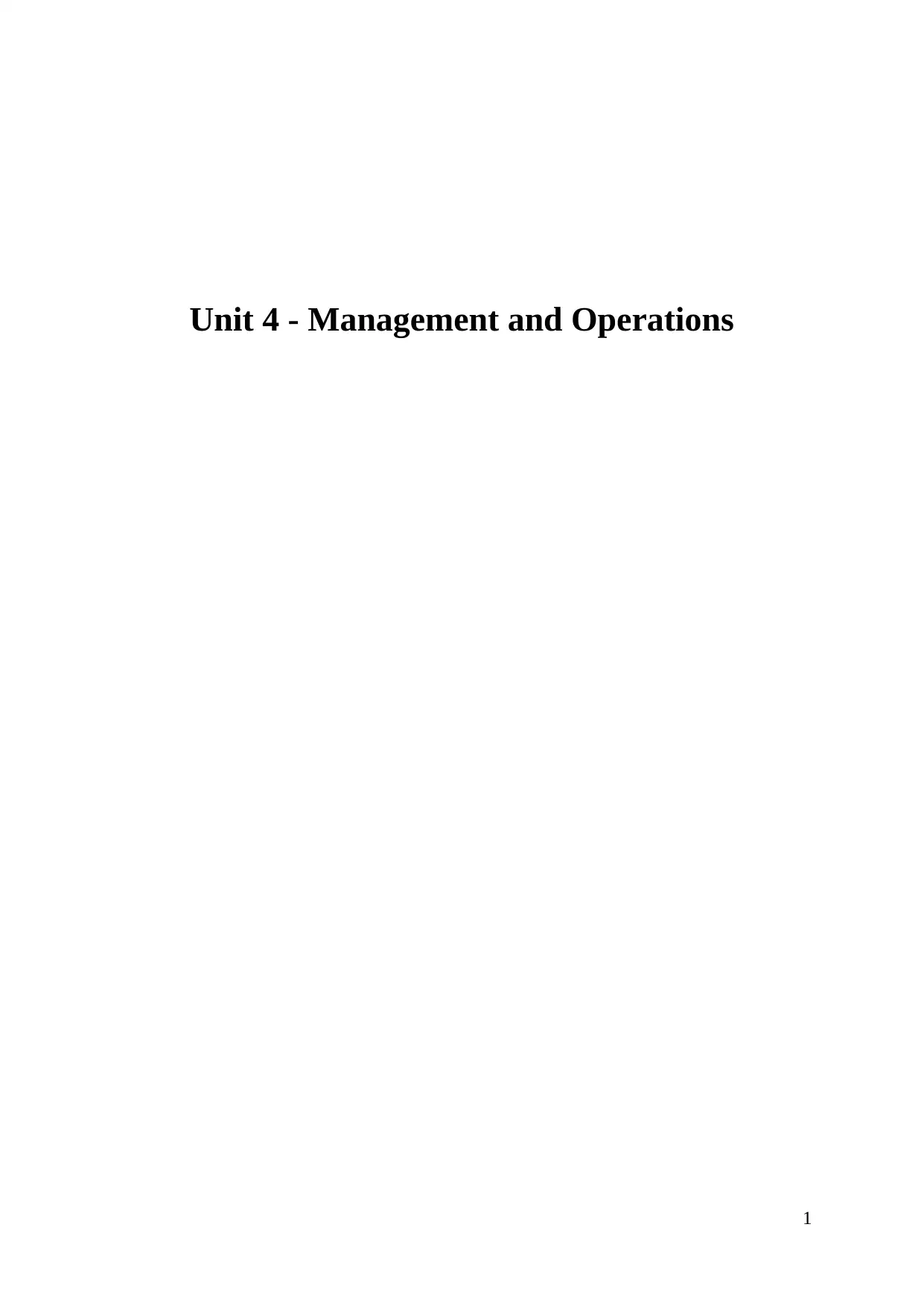
Unit 4 - Management and Operations
1
1
Paraphrase This Document
Need a fresh take? Get an instant paraphrase of this document with our AI Paraphraser
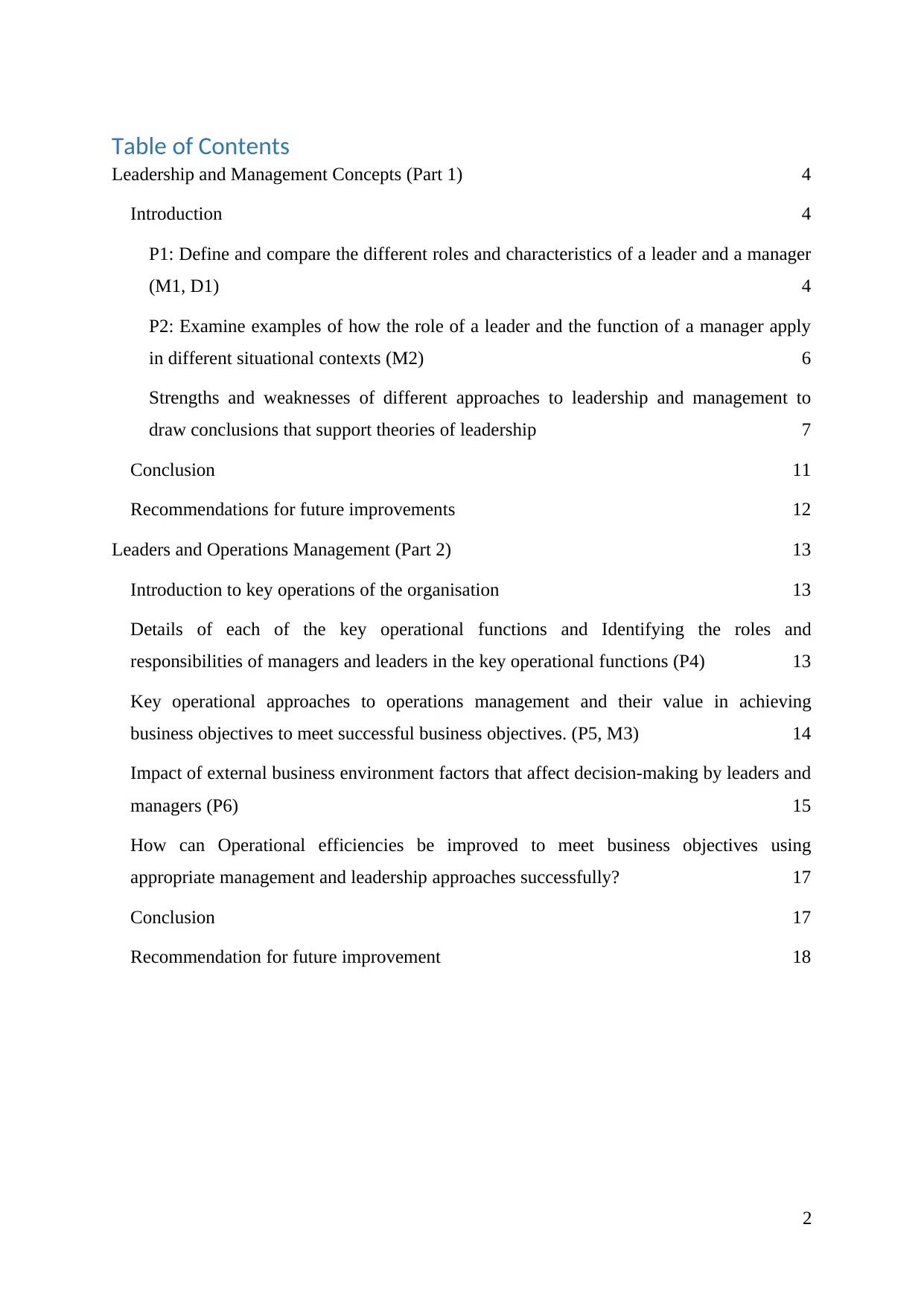
Table of Contents
Leadership and Management Concepts (Part 1) 4
Introduction 4
P1: Define and compare the different roles and characteristics of a leader and a manager
(M1, D1) 4
P2: Examine examples of how the role of a leader and the function of a manager apply
in different situational contexts (M2) 6
Strengths and weaknesses of different approaches to leadership and management to
draw conclusions that support theories of leadership 7
Conclusion 11
Recommendations for future improvements 12
Leaders and Operations Management (Part 2) 13
Introduction to key operations of the organisation 13
Details of each of the key operational functions and Identifying the roles and
responsibilities of managers and leaders in the key operational functions (P4) 13
Key operational approaches to operations management and their value in achieving
business objectives to meet successful business objectives. (P5, M3) 14
Impact of external business environment factors that affect decision-making by leaders and
managers (P6) 15
How can Operational efficiencies be improved to meet business objectives using
appropriate management and leadership approaches successfully? 17
Conclusion 17
Recommendation for future improvement 18
2
Leadership and Management Concepts (Part 1) 4
Introduction 4
P1: Define and compare the different roles and characteristics of a leader and a manager
(M1, D1) 4
P2: Examine examples of how the role of a leader and the function of a manager apply
in different situational contexts (M2) 6
Strengths and weaknesses of different approaches to leadership and management to
draw conclusions that support theories of leadership 7
Conclusion 11
Recommendations for future improvements 12
Leaders and Operations Management (Part 2) 13
Introduction to key operations of the organisation 13
Details of each of the key operational functions and Identifying the roles and
responsibilities of managers and leaders in the key operational functions (P4) 13
Key operational approaches to operations management and their value in achieving
business objectives to meet successful business objectives. (P5, M3) 14
Impact of external business environment factors that affect decision-making by leaders and
managers (P6) 15
How can Operational efficiencies be improved to meet business objectives using
appropriate management and leadership approaches successfully? 17
Conclusion 17
Recommendation for future improvement 18
2

3
⊘ This is a preview!⊘
Do you want full access?
Subscribe today to unlock all pages.

Trusted by 1+ million students worldwide
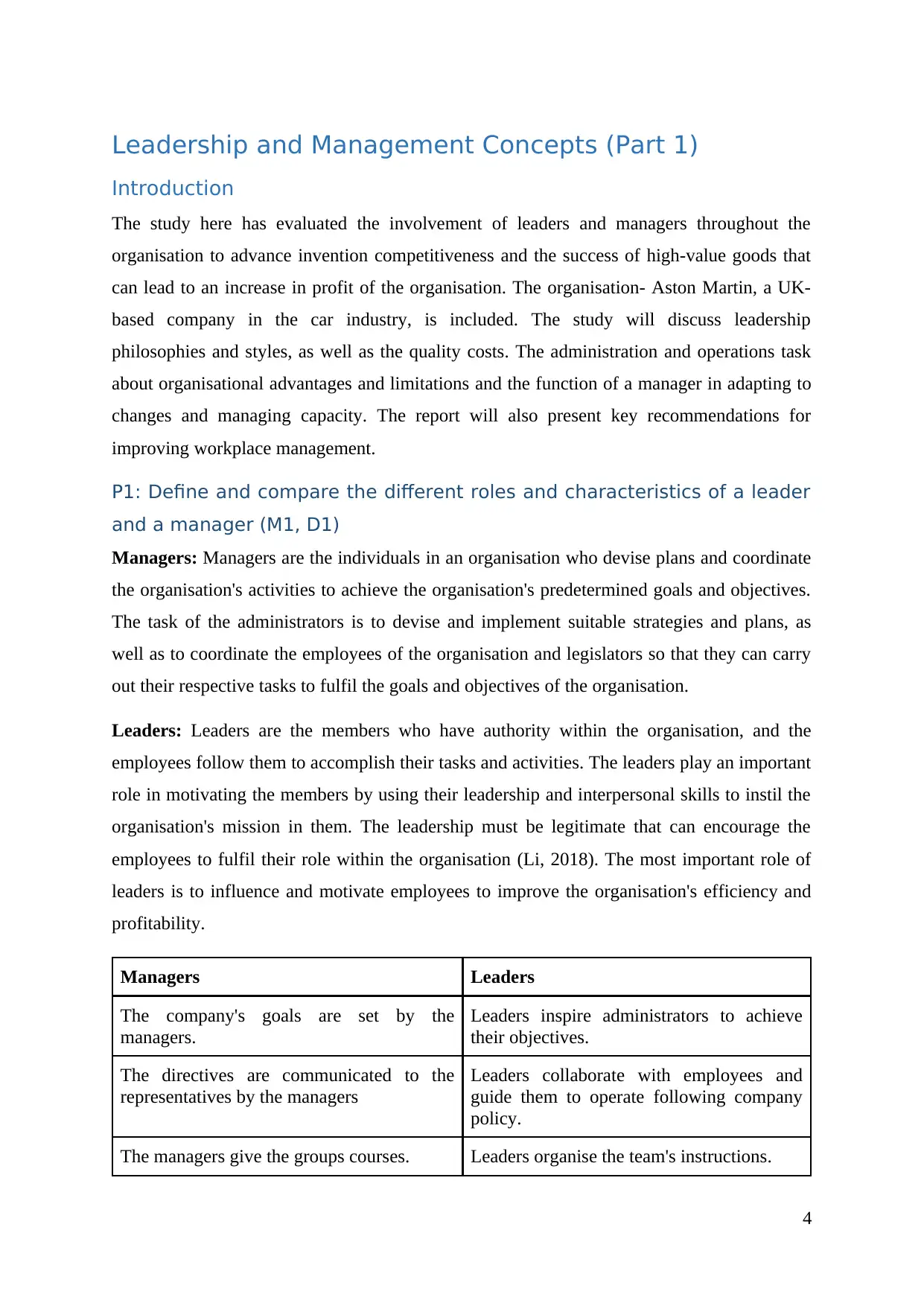
Leadership and Management Concepts (Part 1)
Introduction
The study here has evaluated the involvement of leaders and managers throughout the
organisation to advance invention competitiveness and the success of high-value goods that
can lead to an increase in profit of the organisation. The organisation- Aston Martin, a UK-
based company in the car industry, is included. The study will discuss leadership
philosophies and styles, as well as the quality costs. The administration and operations task
about organisational advantages and limitations and the function of a manager in adapting to
changes and managing capacity. The report will also present key recommendations for
improving workplace management.
P1: Define and compare the different roles and characteristics of a leader
and a manager (M1, D1)
Managers: Managers are the individuals in an organisation who devise plans and coordinate
the organisation's activities to achieve the organisation's predetermined goals and objectives.
The task of the administrators is to devise and implement suitable strategies and plans, as
well as to coordinate the employees of the organisation and legislators so that they can carry
out their respective tasks to fulfil the goals and objectives of the organisation.
Leaders: Leaders are the members who have authority within the organisation, and the
employees follow them to accomplish their tasks and activities. The leaders play an important
role in motivating the members by using their leadership and interpersonal skills to instil the
organisation's mission in them. The leadership must be legitimate that can encourage the
employees to fulfil their role within the organisation (Li, 2018). The most important role of
leaders is to influence and motivate employees to improve the organisation's efficiency and
profitability.
Managers Leaders
The company's goals are set by the
managers.
Leaders inspire administrators to achieve
their objectives.
The directives are communicated to the
representatives by the managers
Leaders collaborate with employees and
guide them to operate following company
policy.
The managers give the groups courses. Leaders organise the team's instructions.
4
Introduction
The study here has evaluated the involvement of leaders and managers throughout the
organisation to advance invention competitiveness and the success of high-value goods that
can lead to an increase in profit of the organisation. The organisation- Aston Martin, a UK-
based company in the car industry, is included. The study will discuss leadership
philosophies and styles, as well as the quality costs. The administration and operations task
about organisational advantages and limitations and the function of a manager in adapting to
changes and managing capacity. The report will also present key recommendations for
improving workplace management.
P1: Define and compare the different roles and characteristics of a leader
and a manager (M1, D1)
Managers: Managers are the individuals in an organisation who devise plans and coordinate
the organisation's activities to achieve the organisation's predetermined goals and objectives.
The task of the administrators is to devise and implement suitable strategies and plans, as
well as to coordinate the employees of the organisation and legislators so that they can carry
out their respective tasks to fulfil the goals and objectives of the organisation.
Leaders: Leaders are the members who have authority within the organisation, and the
employees follow them to accomplish their tasks and activities. The leaders play an important
role in motivating the members by using their leadership and interpersonal skills to instil the
organisation's mission in them. The leadership must be legitimate that can encourage the
employees to fulfil their role within the organisation (Li, 2018). The most important role of
leaders is to influence and motivate employees to improve the organisation's efficiency and
profitability.
Managers Leaders
The company's goals are set by the
managers.
Leaders inspire administrators to achieve
their objectives.
The directives are communicated to the
representatives by the managers
Leaders collaborate with employees and
guide them to operate following company
policy.
The managers give the groups courses. Leaders organise the team's instructions.
4
Paraphrase This Document
Need a fresh take? Get an instant paraphrase of this document with our AI Paraphraser
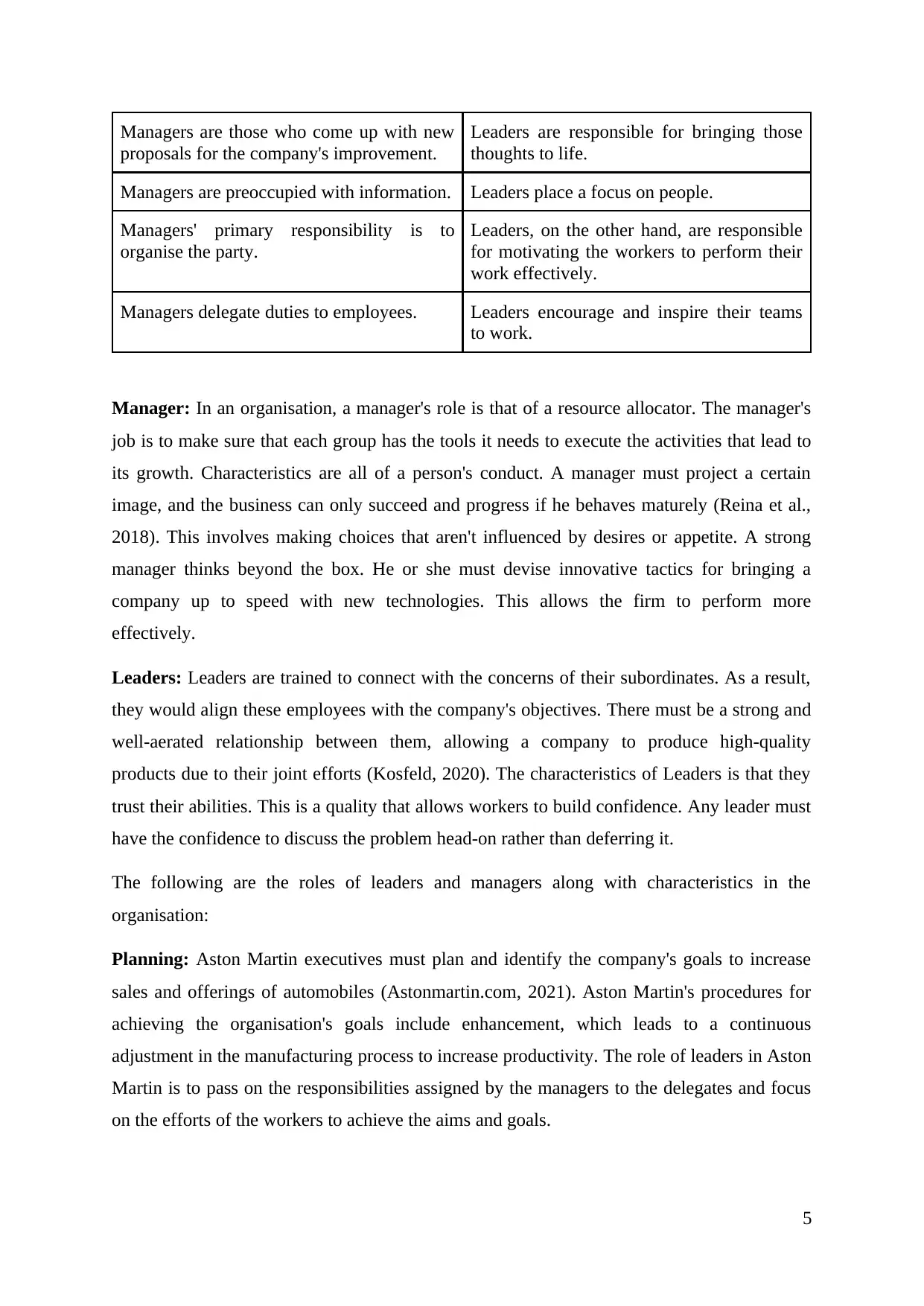
Managers are those who come up with new
proposals for the company's improvement.
Leaders are responsible for bringing those
thoughts to life.
Managers are preoccupied with information. Leaders place a focus on people.
Managers' primary responsibility is to
organise the party.
Leaders, on the other hand, are responsible
for motivating the workers to perform their
work effectively.
Managers delegate duties to employees. Leaders encourage and inspire their teams
to work.
Manager: In an organisation, a manager's role is that of a resource allocator. The manager's
job is to make sure that each group has the tools it needs to execute the activities that lead to
its growth. Characteristics are all of a person's conduct. A manager must project a certain
image, and the business can only succeed and progress if he behaves maturely (Reina et al.,
2018). This involves making choices that aren't influenced by desires or appetite. A strong
manager thinks beyond the box. He or she must devise innovative tactics for bringing a
company up to speed with new technologies. This allows the firm to perform more
effectively.
Leaders: Leaders are trained to connect with the concerns of their subordinates. As a result,
they would align these employees with the company's objectives. There must be a strong and
well-aerated relationship between them, allowing a company to produce high-quality
products due to their joint efforts (Kosfeld, 2020). The characteristics of Leaders is that they
trust their abilities. This is a quality that allows workers to build confidence. Any leader must
have the confidence to discuss the problem head-on rather than deferring it.
The following are the roles of leaders and managers along with characteristics in the
organisation:
Planning: Aston Martin executives must plan and identify the company's goals to increase
sales and offerings of automobiles (Astonmartin.com, 2021). Aston Martin's procedures for
achieving the organisation's goals include enhancement, which leads to a continuous
adjustment in the manufacturing process to increase productivity. The role of leaders in Aston
Martin is to pass on the responsibilities assigned by the managers to the delegates and focus
on the efforts of the workers to achieve the aims and goals.
5
proposals for the company's improvement.
Leaders are responsible for bringing those
thoughts to life.
Managers are preoccupied with information. Leaders place a focus on people.
Managers' primary responsibility is to
organise the party.
Leaders, on the other hand, are responsible
for motivating the workers to perform their
work effectively.
Managers delegate duties to employees. Leaders encourage and inspire their teams
to work.
Manager: In an organisation, a manager's role is that of a resource allocator. The manager's
job is to make sure that each group has the tools it needs to execute the activities that lead to
its growth. Characteristics are all of a person's conduct. A manager must project a certain
image, and the business can only succeed and progress if he behaves maturely (Reina et al.,
2018). This involves making choices that aren't influenced by desires or appetite. A strong
manager thinks beyond the box. He or she must devise innovative tactics for bringing a
company up to speed with new technologies. This allows the firm to perform more
effectively.
Leaders: Leaders are trained to connect with the concerns of their subordinates. As a result,
they would align these employees with the company's objectives. There must be a strong and
well-aerated relationship between them, allowing a company to produce high-quality
products due to their joint efforts (Kosfeld, 2020). The characteristics of Leaders is that they
trust their abilities. This is a quality that allows workers to build confidence. Any leader must
have the confidence to discuss the problem head-on rather than deferring it.
The following are the roles of leaders and managers along with characteristics in the
organisation:
Planning: Aston Martin executives must plan and identify the company's goals to increase
sales and offerings of automobiles (Astonmartin.com, 2021). Aston Martin's procedures for
achieving the organisation's goals include enhancement, which leads to a continuous
adjustment in the manufacturing process to increase productivity. The role of leaders in Aston
Martin is to pass on the responsibilities assigned by the managers to the delegates and focus
on the efforts of the workers to achieve the aims and goals.
5
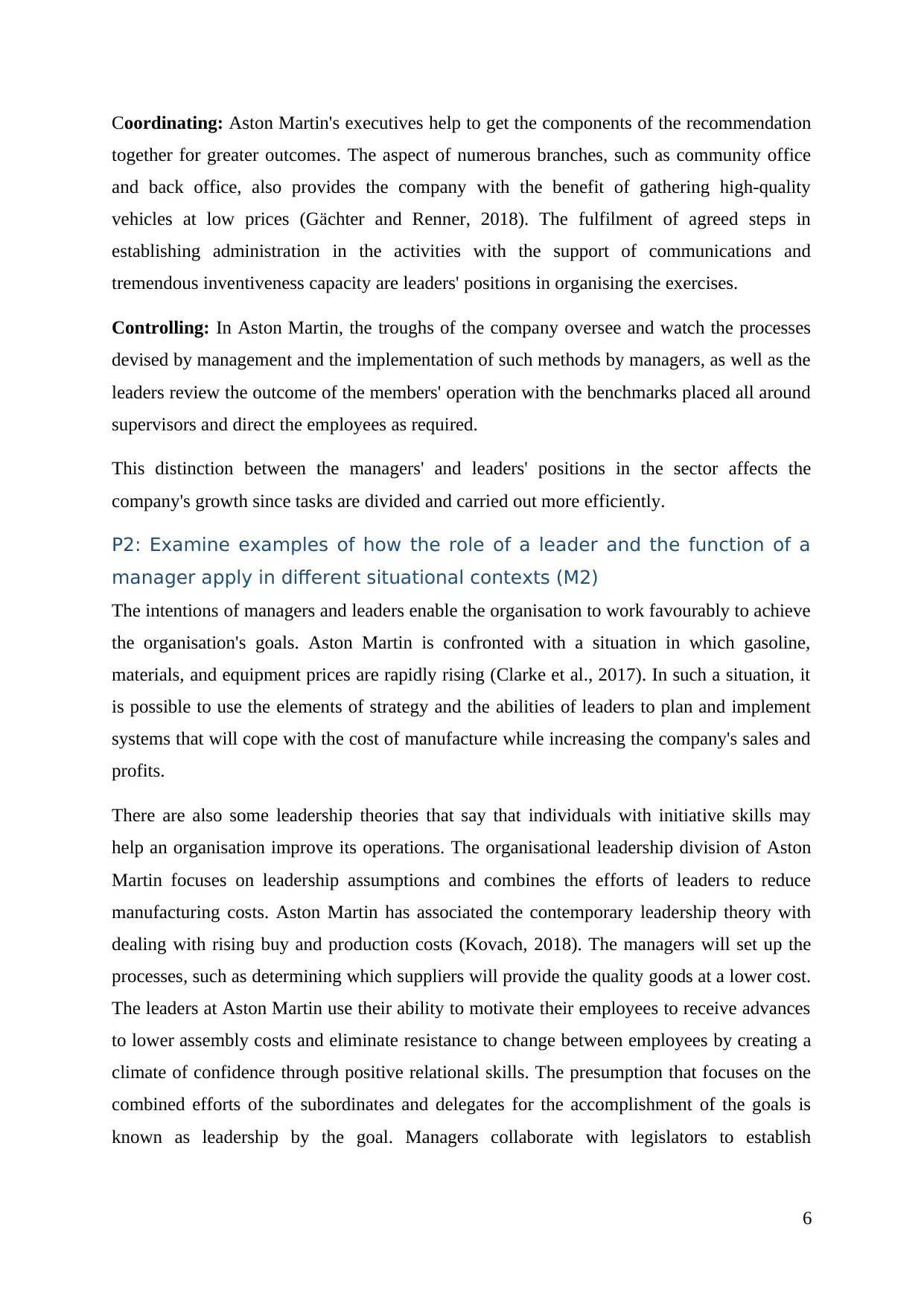
Coordinating: Aston Martin's executives help to get the components of the recommendation
together for greater outcomes. The aspect of numerous branches, such as community office
and back office, also provides the company with the benefit of gathering high-quality
vehicles at low prices (Gächter and Renner, 2018). The fulfilment of agreed steps in
establishing administration in the activities with the support of communications and
tremendous inventiveness capacity are leaders' positions in organising the exercises.
Controlling: In Aston Martin, the troughs of the company oversee and watch the processes
devised by management and the implementation of such methods by managers, as well as the
leaders review the outcome of the members' operation with the benchmarks placed all around
supervisors and direct the employees as required.
This distinction between the managers' and leaders' positions in the sector affects the
company's growth since tasks are divided and carried out more efficiently.
P2: Examine examples of how the role of a leader and the function of a
manager apply in different situational contexts (M2)
The intentions of managers and leaders enable the organisation to work favourably to achieve
the organisation's goals. Aston Martin is confronted with a situation in which gasoline,
materials, and equipment prices are rapidly rising (Clarke et al., 2017). In such a situation, it
is possible to use the elements of strategy and the abilities of leaders to plan and implement
systems that will cope with the cost of manufacture while increasing the company's sales and
profits.
There are also some leadership theories that say that individuals with initiative skills may
help an organisation improve its operations. The organisational leadership division of Aston
Martin focuses on leadership assumptions and combines the efforts of leaders to reduce
manufacturing costs. Aston Martin has associated the contemporary leadership theory with
dealing with rising buy and production costs (Kovach, 2018). The managers will set up the
processes, such as determining which suppliers will provide the quality goods at a lower cost.
The leaders at Aston Martin use their ability to motivate their employees to receive advances
to lower assembly costs and eliminate resistance to change between employees by creating a
climate of confidence through positive relational skills. The presumption that focuses on the
combined efforts of the subordinates and delegates for the accomplishment of the goals is
known as leadership by the goal. Managers collaborate with legislators to establish
6
together for greater outcomes. The aspect of numerous branches, such as community office
and back office, also provides the company with the benefit of gathering high-quality
vehicles at low prices (Gächter and Renner, 2018). The fulfilment of agreed steps in
establishing administration in the activities with the support of communications and
tremendous inventiveness capacity are leaders' positions in organising the exercises.
Controlling: In Aston Martin, the troughs of the company oversee and watch the processes
devised by management and the implementation of such methods by managers, as well as the
leaders review the outcome of the members' operation with the benchmarks placed all around
supervisors and direct the employees as required.
This distinction between the managers' and leaders' positions in the sector affects the
company's growth since tasks are divided and carried out more efficiently.
P2: Examine examples of how the role of a leader and the function of a
manager apply in different situational contexts (M2)
The intentions of managers and leaders enable the organisation to work favourably to achieve
the organisation's goals. Aston Martin is confronted with a situation in which gasoline,
materials, and equipment prices are rapidly rising (Clarke et al., 2017). In such a situation, it
is possible to use the elements of strategy and the abilities of leaders to plan and implement
systems that will cope with the cost of manufacture while increasing the company's sales and
profits.
There are also some leadership theories that say that individuals with initiative skills may
help an organisation improve its operations. The organisational leadership division of Aston
Martin focuses on leadership assumptions and combines the efforts of leaders to reduce
manufacturing costs. Aston Martin has associated the contemporary leadership theory with
dealing with rising buy and production costs (Kovach, 2018). The managers will set up the
processes, such as determining which suppliers will provide the quality goods at a lower cost.
The leaders at Aston Martin use their ability to motivate their employees to receive advances
to lower assembly costs and eliminate resistance to change between employees by creating a
climate of confidence through positive relational skills. The presumption that focuses on the
combined efforts of the subordinates and delegates for the accomplishment of the goals is
known as leadership by the goal. Managers collaborate with legislators to establish
6
⊘ This is a preview!⊘
Do you want full access?
Subscribe today to unlock all pages.

Trusted by 1+ million students worldwide
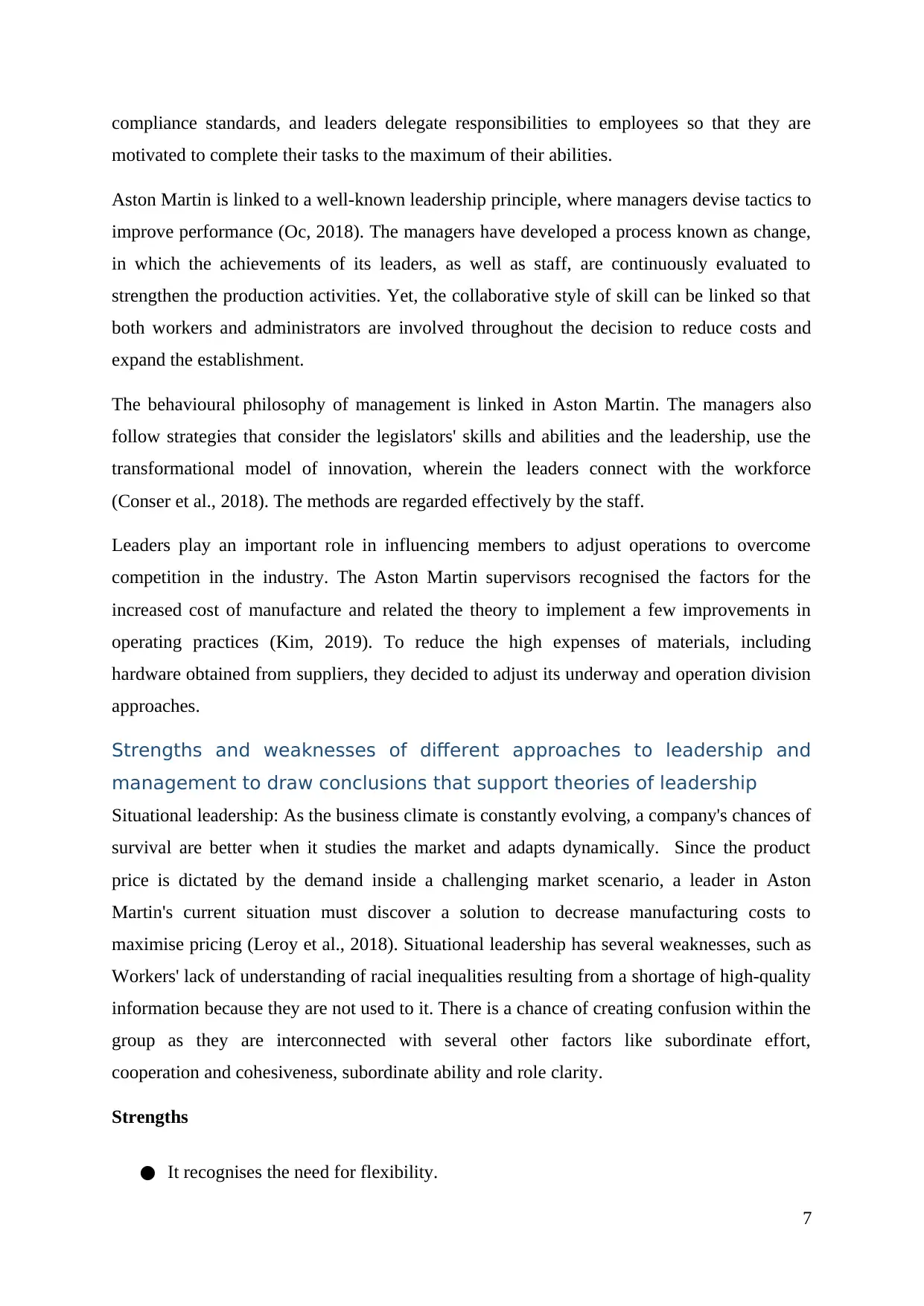
compliance standards, and leaders delegate responsibilities to employees so that they are
motivated to complete their tasks to the maximum of their abilities.
Aston Martin is linked to a well-known leadership principle, where managers devise tactics to
improve performance (Oc, 2018). The managers have developed a process known as change,
in which the achievements of its leaders, as well as staff, are continuously evaluated to
strengthen the production activities. Yet, the collaborative style of skill can be linked so that
both workers and administrators are involved throughout the decision to reduce costs and
expand the establishment.
The behavioural philosophy of management is linked in Aston Martin. The managers also
follow strategies that consider the legislators' skills and abilities and the leadership, use the
transformational model of innovation, wherein the leaders connect with the workforce
(Conser et al., 2018). The methods are regarded effectively by the staff.
Leaders play an important role in influencing members to adjust operations to overcome
competition in the industry. The Aston Martin supervisors recognised the factors for the
increased cost of manufacture and related the theory to implement a few improvements in
operating practices (Kim, 2019). To reduce the high expenses of materials, including
hardware obtained from suppliers, they decided to adjust its underway and operation division
approaches.
Strengths and weaknesses of different approaches to leadership and
management to draw conclusions that support theories of leadership
Situational leadership: As the business climate is constantly evolving, a company's chances of
survival are better when it studies the market and adapts dynamically. Since the product
price is dictated by the demand inside a challenging market scenario, a leader in Aston
Martin's current situation must discover a solution to decrease manufacturing costs to
maximise pricing (Leroy et al., 2018). Situational leadership has several weaknesses, such as
Workers' lack of understanding of racial inequalities resulting from a shortage of high-quality
information because they are not used to it. There is a chance of creating confusion within the
group as they are interconnected with several other factors like subordinate effort,
cooperation and cohesiveness, subordinate ability and role clarity.
Strengths
● It recognises the need for flexibility.
7
motivated to complete their tasks to the maximum of their abilities.
Aston Martin is linked to a well-known leadership principle, where managers devise tactics to
improve performance (Oc, 2018). The managers have developed a process known as change,
in which the achievements of its leaders, as well as staff, are continuously evaluated to
strengthen the production activities. Yet, the collaborative style of skill can be linked so that
both workers and administrators are involved throughout the decision to reduce costs and
expand the establishment.
The behavioural philosophy of management is linked in Aston Martin. The managers also
follow strategies that consider the legislators' skills and abilities and the leadership, use the
transformational model of innovation, wherein the leaders connect with the workforce
(Conser et al., 2018). The methods are regarded effectively by the staff.
Leaders play an important role in influencing members to adjust operations to overcome
competition in the industry. The Aston Martin supervisors recognised the factors for the
increased cost of manufacture and related the theory to implement a few improvements in
operating practices (Kim, 2019). To reduce the high expenses of materials, including
hardware obtained from suppliers, they decided to adjust its underway and operation division
approaches.
Strengths and weaknesses of different approaches to leadership and
management to draw conclusions that support theories of leadership
Situational leadership: As the business climate is constantly evolving, a company's chances of
survival are better when it studies the market and adapts dynamically. Since the product
price is dictated by the demand inside a challenging market scenario, a leader in Aston
Martin's current situation must discover a solution to decrease manufacturing costs to
maximise pricing (Leroy et al., 2018). Situational leadership has several weaknesses, such as
Workers' lack of understanding of racial inequalities resulting from a shortage of high-quality
information because they are not used to it. There is a chance of creating confusion within the
group as they are interconnected with several other factors like subordinate effort,
cooperation and cohesiveness, subordinate ability and role clarity.
Strengths
● It recognises the need for flexibility.
7
Paraphrase This Document
Need a fresh take? Get an instant paraphrase of this document with our AI Paraphraser
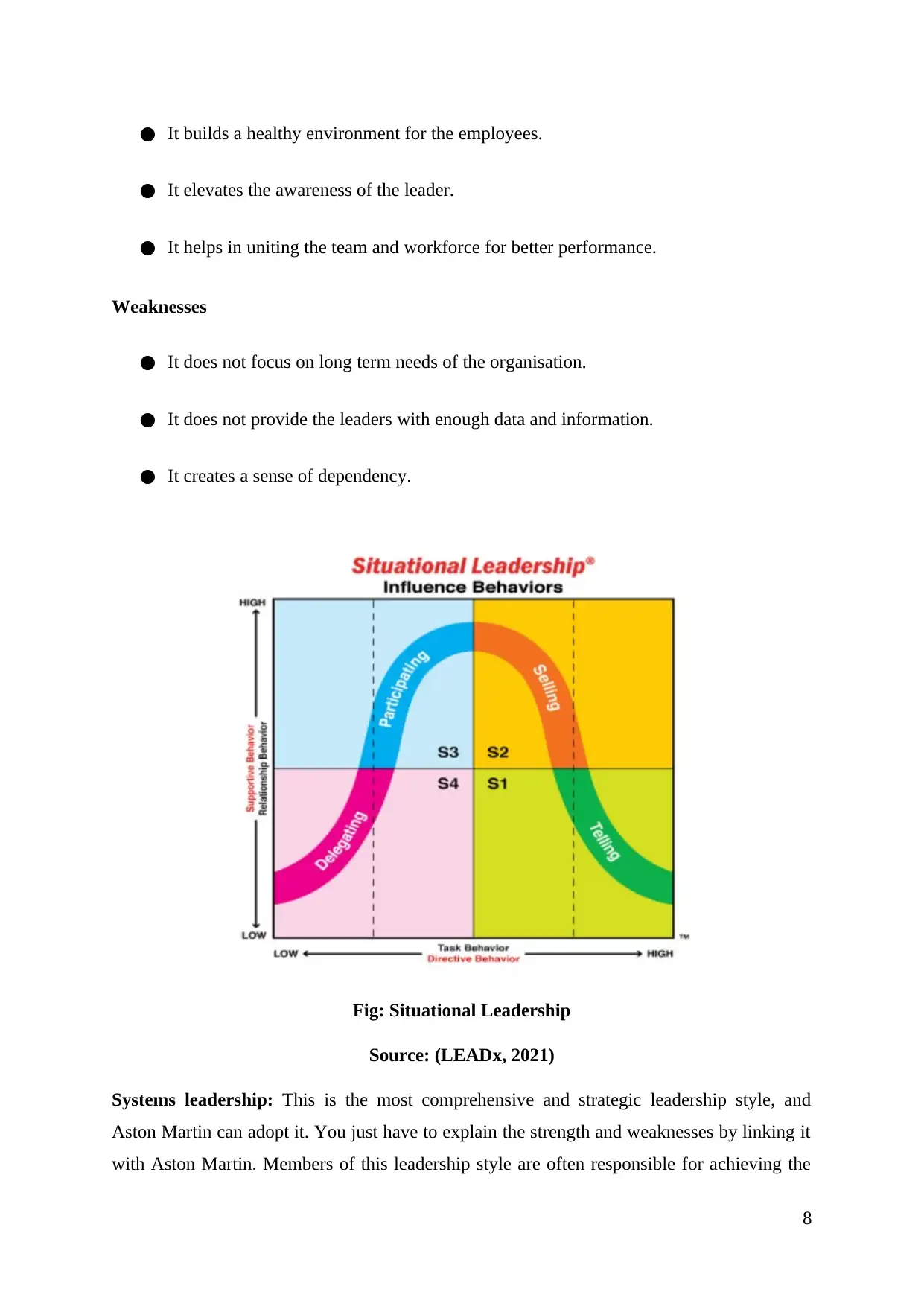
● It builds a healthy environment for the employees.
● It elevates the awareness of the leader.
● It helps in uniting the team and workforce for better performance.
Weaknesses
● It does not focus on long term needs of the organisation.
● It does not provide the leaders with enough data and information.
● It creates a sense of dependency.
Fig: Situational Leadership
Source: (LEADx, 2021)
Systems leadership: This is the most comprehensive and strategic leadership style, and
Aston Martin can adopt it. You just have to explain the strength and weaknesses by linking it
with Aston Martin. Members of this leadership style are often responsible for achieving the
8
● It elevates the awareness of the leader.
● It helps in uniting the team and workforce for better performance.
Weaknesses
● It does not focus on long term needs of the organisation.
● It does not provide the leaders with enough data and information.
● It creates a sense of dependency.
Fig: Situational Leadership
Source: (LEADx, 2021)
Systems leadership: This is the most comprehensive and strategic leadership style, and
Aston Martin can adopt it. You just have to explain the strength and weaknesses by linking it
with Aston Martin. Members of this leadership style are often responsible for achieving the
8
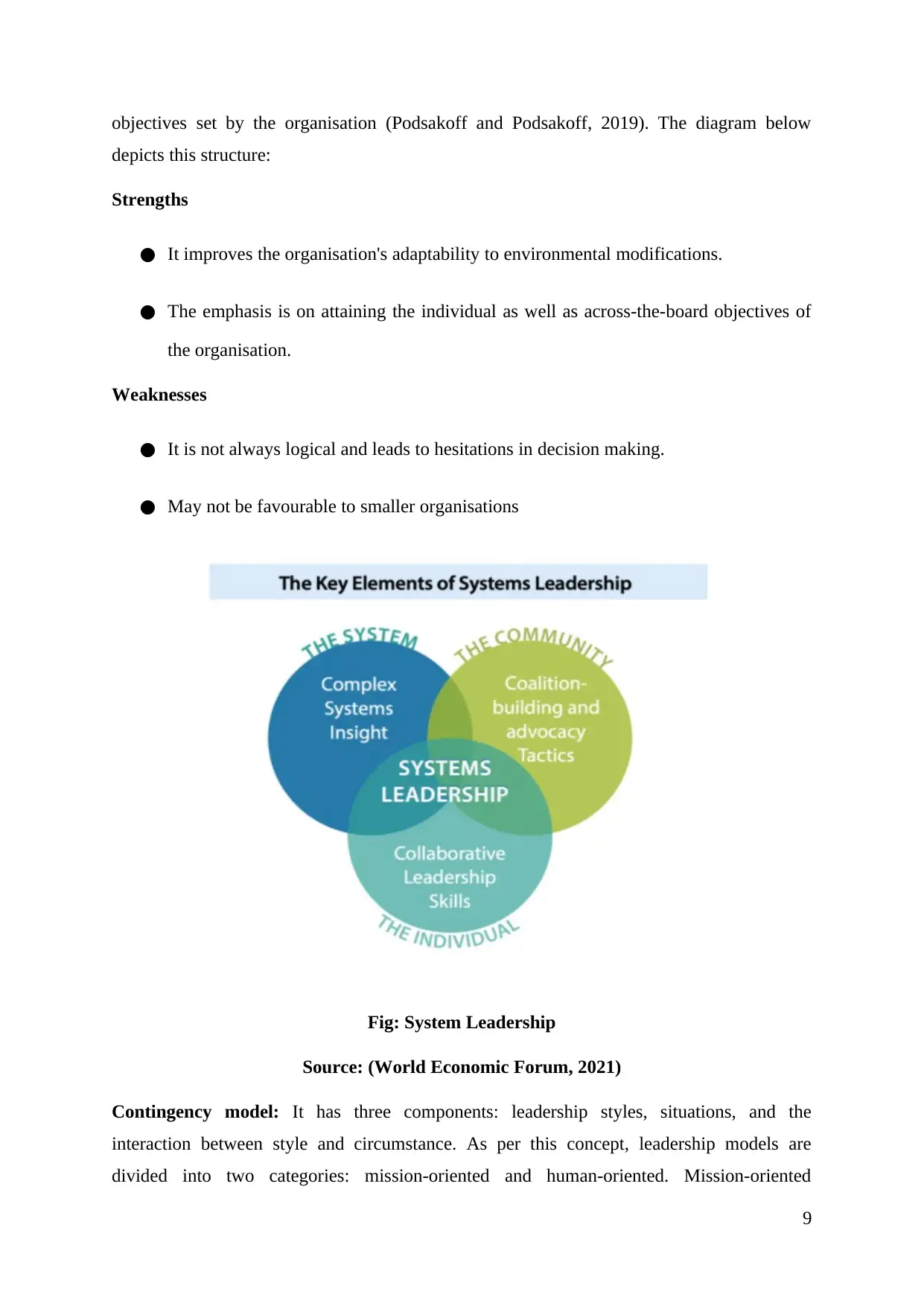
objectives set by the organisation (Podsakoff and Podsakoff, 2019). The diagram below
depicts this structure:
Strengths
● It improves the organisation's adaptability to environmental modifications.
● The emphasis is on attaining the individual as well as across-the-board objectives of
the organisation.
Weaknesses
● It is not always logical and leads to hesitations in decision making.
● May not be favourable to smaller organisations
Fig: System Leadership
Source: (World Economic Forum, 2021)
Contingency model: It has three components: leadership styles, situations, and the
interaction between style and circumstance. As per this concept, leadership models are
divided into two categories: mission-oriented and human-oriented. Mission-oriented
9
depicts this structure:
Strengths
● It improves the organisation's adaptability to environmental modifications.
● The emphasis is on attaining the individual as well as across-the-board objectives of
the organisation.
Weaknesses
● It is not always logical and leads to hesitations in decision making.
● May not be favourable to smaller organisations
Fig: System Leadership
Source: (World Economic Forum, 2021)
Contingency model: It has three components: leadership styles, situations, and the
interaction between style and circumstance. As per this concept, leadership models are
divided into two categories: mission-oriented and human-oriented. Mission-oriented
9
⊘ This is a preview!⊘
Do you want full access?
Subscribe today to unlock all pages.

Trusted by 1+ million students worldwide
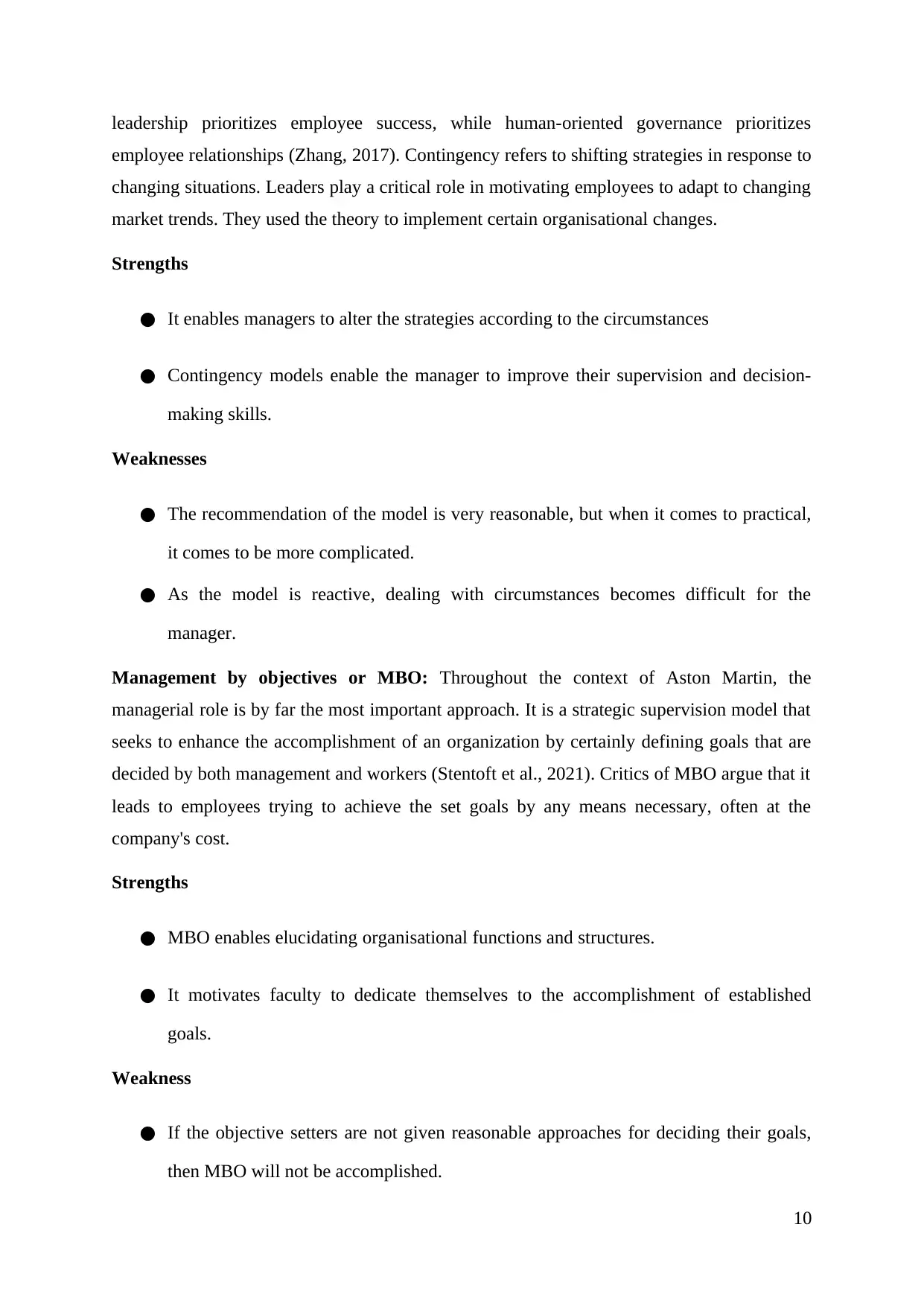
leadership prioritizes employee success, while human-oriented governance prioritizes
employee relationships (Zhang, 2017). Contingency refers to shifting strategies in response to
changing situations. Leaders play a critical role in motivating employees to adapt to changing
market trends. They used the theory to implement certain organisational changes.
Strengths
● It enables managers to alter the strategies according to the circumstances
● Contingency models enable the manager to improve their supervision and decision-
making skills.
Weaknesses
● The recommendation of the model is very reasonable, but when it comes to practical,
it comes to be more complicated.
● As the model is reactive, dealing with circumstances becomes difficult for the
manager.
Management by objectives or MBO: Throughout the context of Aston Martin, the
managerial role is by far the most important approach. It is a strategic supervision model that
seeks to enhance the accomplishment of an organization by certainly defining goals that are
decided by both management and workers (Stentoft et al., 2021). Critics of MBO argue that it
leads to employees trying to achieve the set goals by any means necessary, often at the
company's cost.
Strengths
● MBO enables elucidating organisational functions and structures.
● It motivates faculty to dedicate themselves to the accomplishment of established
goals.
Weakness
● If the objective setters are not given reasonable approaches for deciding their goals,
then MBO will not be accomplished.
10
employee relationships (Zhang, 2017). Contingency refers to shifting strategies in response to
changing situations. Leaders play a critical role in motivating employees to adapt to changing
market trends. They used the theory to implement certain organisational changes.
Strengths
● It enables managers to alter the strategies according to the circumstances
● Contingency models enable the manager to improve their supervision and decision-
making skills.
Weaknesses
● The recommendation of the model is very reasonable, but when it comes to practical,
it comes to be more complicated.
● As the model is reactive, dealing with circumstances becomes difficult for the
manager.
Management by objectives or MBO: Throughout the context of Aston Martin, the
managerial role is by far the most important approach. It is a strategic supervision model that
seeks to enhance the accomplishment of an organization by certainly defining goals that are
decided by both management and workers (Stentoft et al., 2021). Critics of MBO argue that it
leads to employees trying to achieve the set goals by any means necessary, often at the
company's cost.
Strengths
● MBO enables elucidating organisational functions and structures.
● It motivates faculty to dedicate themselves to the accomplishment of established
goals.
Weakness
● If the objective setters are not given reasonable approaches for deciding their goals,
then MBO will not be accomplished.
10
Paraphrase This Document
Need a fresh take? Get an instant paraphrase of this document with our AI Paraphraser
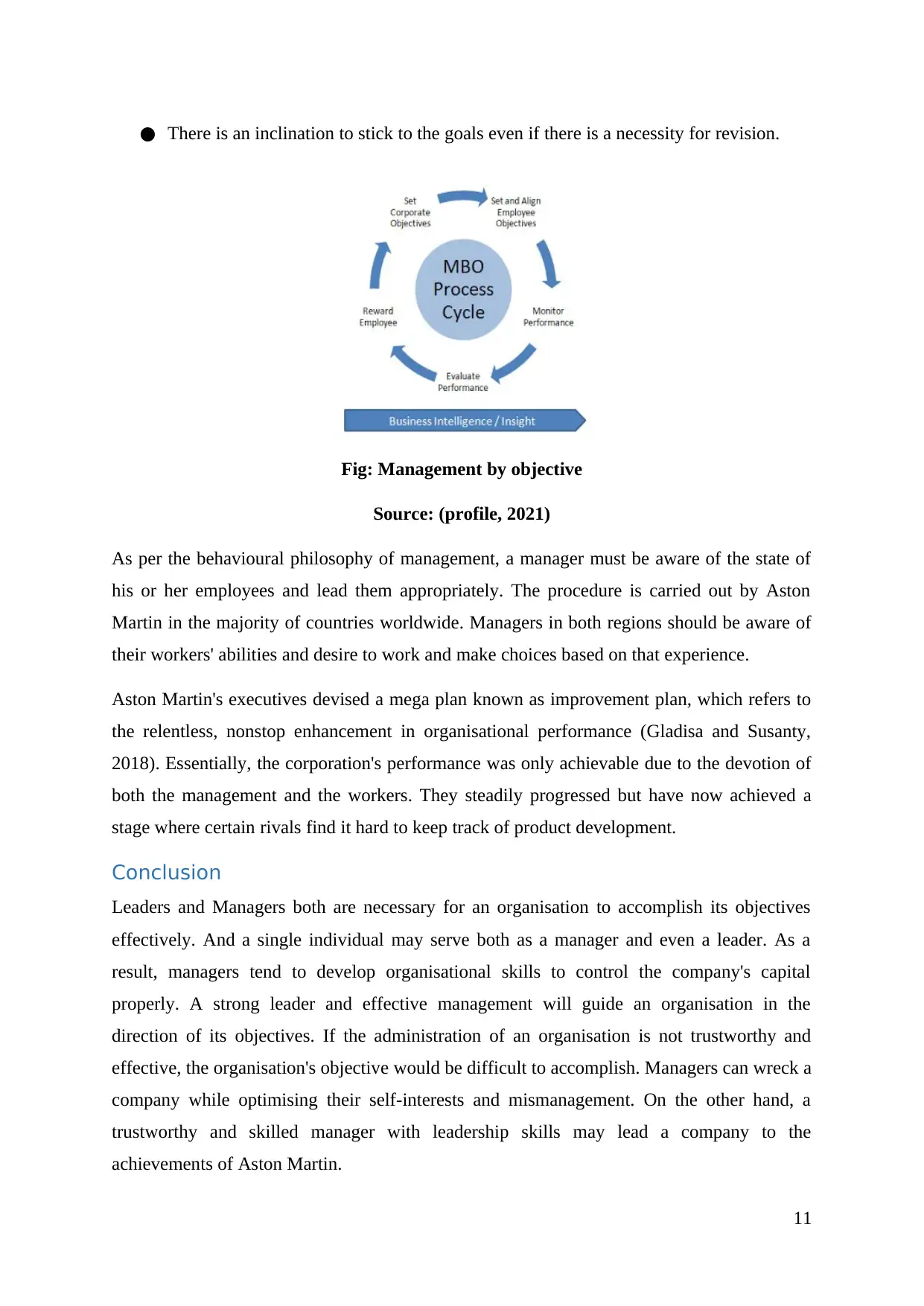
● There is an inclination to stick to the goals even if there is a necessity for revision.
Fig: Management by objective
Source: (profile, 2021)
As per the behavioural philosophy of management, a manager must be aware of the state of
his or her employees and lead them appropriately. The procedure is carried out by Aston
Martin in the majority of countries worldwide. Managers in both regions should be aware of
their workers' abilities and desire to work and make choices based on that experience.
Aston Martin's executives devised a mega plan known as improvement plan, which refers to
the relentless, nonstop enhancement in organisational performance (Gladisa and Susanty,
2018). Essentially, the corporation's performance was only achievable due to the devotion of
both the management and the workers. They steadily progressed but have now achieved a
stage where certain rivals find it hard to keep track of product development.
Conclusion
Leaders and Managers both are necessary for an organisation to accomplish its objectives
effectively. And a single individual may serve both as a manager and even a leader. As a
result, managers tend to develop organisational skills to control the company's capital
properly. A strong leader and effective management will guide an organisation in the
direction of its objectives. If the administration of an organisation is not trustworthy and
effective, the organisation's objective would be difficult to accomplish. Managers can wreck a
company while optimising their self-interests and mismanagement. On the other hand, a
trustworthy and skilled manager with leadership skills may lead a company to the
achievements of Aston Martin.
11
Fig: Management by objective
Source: (profile, 2021)
As per the behavioural philosophy of management, a manager must be aware of the state of
his or her employees and lead them appropriately. The procedure is carried out by Aston
Martin in the majority of countries worldwide. Managers in both regions should be aware of
their workers' abilities and desire to work and make choices based on that experience.
Aston Martin's executives devised a mega plan known as improvement plan, which refers to
the relentless, nonstop enhancement in organisational performance (Gladisa and Susanty,
2018). Essentially, the corporation's performance was only achievable due to the devotion of
both the management and the workers. They steadily progressed but have now achieved a
stage where certain rivals find it hard to keep track of product development.
Conclusion
Leaders and Managers both are necessary for an organisation to accomplish its objectives
effectively. And a single individual may serve both as a manager and even a leader. As a
result, managers tend to develop organisational skills to control the company's capital
properly. A strong leader and effective management will guide an organisation in the
direction of its objectives. If the administration of an organisation is not trustworthy and
effective, the organisation's objective would be difficult to accomplish. Managers can wreck a
company while optimising their self-interests and mismanagement. On the other hand, a
trustworthy and skilled manager with leadership skills may lead a company to the
achievements of Aston Martin.
11
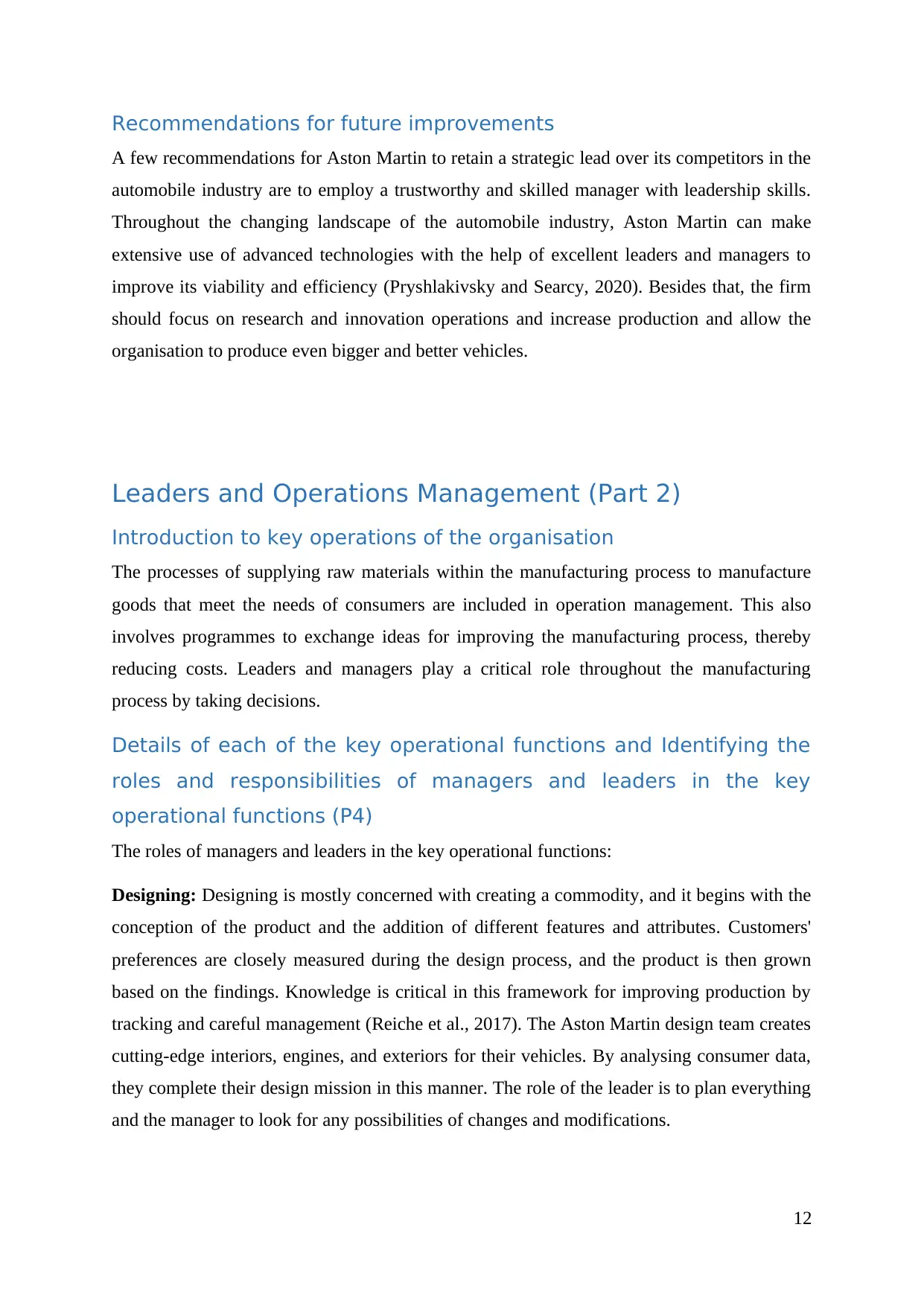
Recommendations for future improvements
A few recommendations for Aston Martin to retain a strategic lead over its competitors in the
automobile industry are to employ a trustworthy and skilled manager with leadership skills.
Throughout the changing landscape of the automobile industry, Aston Martin can make
extensive use of advanced technologies with the help of excellent leaders and managers to
improve its viability and efficiency (Pryshlakivsky and Searcy, 2020). Besides that, the firm
should focus on research and innovation operations and increase production and allow the
organisation to produce even bigger and better vehicles.
Leaders and Operations Management (Part 2)
Introduction to key operations of the organisation
The processes of supplying raw materials within the manufacturing process to manufacture
goods that meet the needs of consumers are included in operation management. This also
involves programmes to exchange ideas for improving the manufacturing process, thereby
reducing costs. Leaders and managers play a critical role throughout the manufacturing
process by taking decisions.
Details of each of the key operational functions and Identifying the
roles and responsibilities of managers and leaders in the key
operational functions (P4)
The roles of managers and leaders in the key operational functions:
Designing: Designing is mostly concerned with creating a commodity, and it begins with the
conception of the product and the addition of different features and attributes. Customers'
preferences are closely measured during the design process, and the product is then grown
based on the findings. Knowledge is critical in this framework for improving production by
tracking and careful management (Reiche et al., 2017). The Aston Martin design team creates
cutting-edge interiors, engines, and exteriors for their vehicles. By analysing consumer data,
they complete their design mission in this manner. The role of the leader is to plan everything
and the manager to look for any possibilities of changes and modifications.
12
A few recommendations for Aston Martin to retain a strategic lead over its competitors in the
automobile industry are to employ a trustworthy and skilled manager with leadership skills.
Throughout the changing landscape of the automobile industry, Aston Martin can make
extensive use of advanced technologies with the help of excellent leaders and managers to
improve its viability and efficiency (Pryshlakivsky and Searcy, 2020). Besides that, the firm
should focus on research and innovation operations and increase production and allow the
organisation to produce even bigger and better vehicles.
Leaders and Operations Management (Part 2)
Introduction to key operations of the organisation
The processes of supplying raw materials within the manufacturing process to manufacture
goods that meet the needs of consumers are included in operation management. This also
involves programmes to exchange ideas for improving the manufacturing process, thereby
reducing costs. Leaders and managers play a critical role throughout the manufacturing
process by taking decisions.
Details of each of the key operational functions and Identifying the
roles and responsibilities of managers and leaders in the key
operational functions (P4)
The roles of managers and leaders in the key operational functions:
Designing: Designing is mostly concerned with creating a commodity, and it begins with the
conception of the product and the addition of different features and attributes. Customers'
preferences are closely measured during the design process, and the product is then grown
based on the findings. Knowledge is critical in this framework for improving production by
tracking and careful management (Reiche et al., 2017). The Aston Martin design team creates
cutting-edge interiors, engines, and exteriors for their vehicles. By analysing consumer data,
they complete their design mission in this manner. The role of the leader is to plan everything
and the manager to look for any possibilities of changes and modifications.
12
⊘ This is a preview!⊘
Do you want full access?
Subscribe today to unlock all pages.

Trusted by 1+ million students worldwide
1 out of 22
Related Documents
Your All-in-One AI-Powered Toolkit for Academic Success.
+13062052269
info@desklib.com
Available 24*7 on WhatsApp / Email
![[object Object]](/_next/static/media/star-bottom.7253800d.svg)
Unlock your academic potential
Copyright © 2020–2025 A2Z Services. All Rights Reserved. Developed and managed by ZUCOL.




